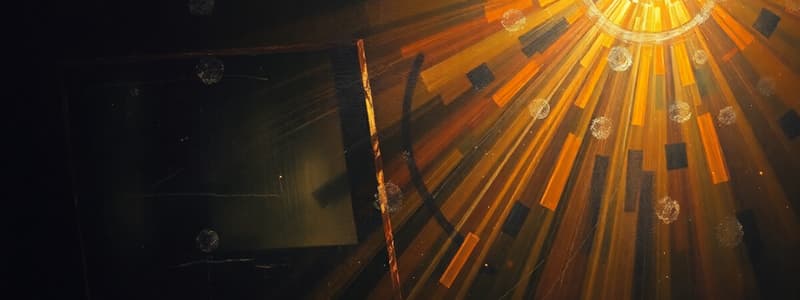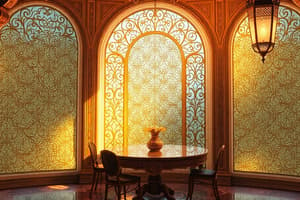Podcast
Questions and Answers
Which of the following is NOT a component of Ontario's Climate Plan?
Which of the following is NOT a component of Ontario's Climate Plan?
- Sustainable building materials
- Increased fossil fuel use (correct)
- Improved energy efficiency in buildings
- Waste reduction and recycling
Transportation is one of the largest sources of greenhouse gas emissions in Canada.
Transportation is one of the largest sources of greenhouse gas emissions in Canada.
True (A)
What is the definition of a luminous object?
What is the definition of a luminous object?
An object that produces its own light.
Incandescence is the light produced by a ______ object.
Incandescence is the light produced by a ______ object.
Match the following examples with their corresponding categories of light objects:
Match the following examples with their corresponding categories of light objects:
What type of image is formed by a converging mirror when it is located between C and F?
What type of image is formed by a converging mirror when it is located between C and F?
The image produced by a diverging mirror is larger than the object.
The image produced by a diverging mirror is larger than the object.
What is the image attitude when a real image is formed at point C by a converging mirror?
What is the image attitude when a real image is formed at point C by a converging mirror?
The image formed by a diverging mirror is always __________.
The image formed by a diverging mirror is always __________.
Match the characteristics of the image formed by a converging mirror to their descriptions:
Match the characteristics of the image formed by a converging mirror to their descriptions:
What is a key difference between phosphorescence and fluorescence?
What is a key difference between phosphorescence and fluorescence?
Incandescent bulbs produce light without generating heat.
Incandescent bulbs produce light without generating heat.
What type of material allows no light to pass through?
What type of material allows no light to pass through?
A _____ allows some light to pass but does not allow clear visibility.
A _____ allows some light to pass but does not allow clear visibility.
Match the following terms about light with their correct descriptions:
Match the following terms about light with their correct descriptions:
What type of reflection occurs when light scatters in many directions off a surface like paper?
What type of reflection occurs when light scatters in many directions off a surface like paper?
The angle of incidence is always different from the angle of reflection.
The angle of incidence is always different from the angle of reflection.
What is the attitude of the image formed by a concave mirror?
What is the attitude of the image formed by a concave mirror?
In specular reflection, light reflects off a ______ surface in one direction.
In specular reflection, light reflects off a ______ surface in one direction.
Match the following types of reflections with their descriptions:
Match the following types of reflections with their descriptions:
What is the formula for the index of refraction (n)?
What is the formula for the index of refraction (n)?
Total internal reflection can occur when light travels from a less dense medium to a denser medium.
Total internal reflection can occur when light travels from a less dense medium to a denser medium.
What is the critical angle for total internal reflection in the example provided?
What is the critical angle for total internal reflection in the example provided?
The speed of light in a vacuum is approximately ______ m/s.
The speed of light in a vacuum is approximately ______ m/s.
Match the following types of light phenomena with their descriptions:
Match the following types of light phenomena with their descriptions:
What is the correct relationship expressed by the thin lens equation?
What is the correct relationship expressed by the thin lens equation?
The image formed by a microscope is always upright.
The image formed by a microscope is always upright.
What is the focal length of a lens if the object distance is 53 cm and the image distance is 27.3 cm?
What is the focal length of a lens if the object distance is 53 cm and the image distance is 27.3 cm?
A camera produces a __________ image that is smaller and inverted.
A camera produces a __________ image that is smaller and inverted.
Match the following lens types with their characteristics:
Match the following lens types with their characteristics:
Which of the following correctly describes a converging lens?
Which of the following correctly describes a converging lens?
A diverging lens has a positive focal point.
A diverging lens has a positive focal point.
What are the three main components labeled in the diagrams of both lens types?
What are the three main components labeled in the diagrams of both lens types?
The path of light rays through a ______ lens diverges.
The path of light rays through a ______ lens diverges.
Match the following terms with their definitions:
Match the following terms with their definitions:
What type of image is formed when an object is located beyond $2F$ using a converging lens?
What type of image is formed when an object is located beyond $2F$ using a converging lens?
An object located between $F$ and $2F$ results in a virtual and larger image.
An object located between $F$ and $2F$ results in a virtual and larger image.
What happens to light rays that pass through the center of a converging lens?
What happens to light rays that pass through the center of a converging lens?
When an object is at $2F$, the image formed is _____ and of _____ size compared to the object.
When an object is at $2F$, the image formed is _____ and of _____ size compared to the object.
Match the following scenarios to the type of image formed:
Match the following scenarios to the type of image formed:
Flashcards
Sustainable farming practices
Sustainable farming practices
The practice of using less synthetic fertilizers to reduce greenhouse gas emissions and promote sustainable agriculture.
Incandescent Objects
Incandescent Objects
Objects that radiate light due to their high temperature.
Non-Luminous Objects
Non-Luminous Objects
Objects that do not produce their own light but reflect light from other sources.
Ontario's Climate Plan
Ontario's Climate Plan
Signup and view all the flashcards
Reduced Consumption at Home
Reduced Consumption at Home
Signup and view all the flashcards
What is a converging mirror?
What is a converging mirror?
Signup and view all the flashcards
What happens to the image formed by a converging mirror?
What happens to the image formed by a converging mirror?
Signup and view all the flashcards
Where is the image located in a converging mirror?
Where is the image located in a converging mirror?
Signup and view all the flashcards
What is a diverging mirror?
What is a diverging mirror?
Signup and view all the flashcards
What kind of image does a diverging mirror create?
What kind of image does a diverging mirror create?
Signup and view all the flashcards
Index of Refraction (n)
Index of Refraction (n)
Signup and view all the flashcards
Refraction
Refraction
Signup and view all the flashcards
Total Internal Reflection
Total Internal Reflection
Signup and view all the flashcards
Critical Angle
Critical Angle
Signup and view all the flashcards
Conditions for Total Internal Reflection
Conditions for Total Internal Reflection
Signup and view all the flashcards
Transparent Material
Transparent Material
Signup and view all the flashcards
What is the incident ray?
What is the incident ray?
Signup and view all the flashcards
Translucent Material
Translucent Material
Signup and view all the flashcards
Angle of Incidence
Angle of Incidence
Signup and view all the flashcards
Opaque Material
Opaque Material
Signup and view all the flashcards
Focal length (f)
Focal length (f)
Signup and view all the flashcards
Object distance (do)
Object distance (do)
Signup and view all the flashcards
Image distance (di)
Image distance (di)
Signup and view all the flashcards
Thin Lens Equation
Thin Lens Equation
Signup and view all the flashcards
Converging Lens
Converging Lens
Signup and view all the flashcards
Law of Reflection
Law of Reflection
Signup and view all the flashcards
Specular Reflection
Specular Reflection
Signup and view all the flashcards
Diffuse Reflection
Diffuse Reflection
Signup and view all the flashcards
Virtual Image
Virtual Image
Signup and view all the flashcards
Rules for a Concave Mirror
Rules for a Concave Mirror
Signup and view all the flashcards
Diverging Lens
Diverging Lens
Signup and view all the flashcards
Focal Point (F)
Focal Point (F)
Signup and view all the flashcards
Principal Axis
Principal Axis
Signup and view all the flashcards
Optical Center
Optical Center
Signup and view all the flashcards
Converging Lens: Light Ray Rule 1
Converging Lens: Light Ray Rule 1
Signup and view all the flashcards
Converging Lens: Light Ray Rule 2
Converging Lens: Light Ray Rule 2
Signup and view all the flashcards
Converging Lens: Light Ray Rule 3
Converging Lens: Light Ray Rule 3
Signup and view all the flashcards
Converging Lenses: Image Formation
Converging Lenses: Image Formation
Signup and view all the flashcards
Object Beyond 2F: Converging Lens
Object Beyond 2F: Converging Lens
Signup and view all the flashcards
Study Notes
Light and Reflection
- Light sources are categorized into luminous and non-luminous
- Luminous objects produce their own light (e.g., sun, light bulb)
- Non-luminous objects reflect light (e.g., mirrors, moon)
- Incandescence is light produced from a hot object (e.g., candle)
Refraction
- Refraction is the bending of light when it passes from one medium to another
- The speed of light changes when it enters a different medium.
- The larger the difference in mediums, the larger the change in speed.
- Refraction is calculated using the formula n=c/v
- Examples of mediums are glass, water
- Formula n=c/v (index of refraction = speed of light in vacuum/speed of light in medium).
- Example applications include how a pencil appears bent when placed in water, prisms, and rainbows.
Total Internal Reflection
- Total internal reflection occurs when light travels from a denser medium to a less dense medium and the angle of incidence is greater than the critical angle.
- Conditions for total internal reflection:
- Light must travel from a denser to a less dense medium
- Angle of incidence must be greater than critical angle.
Studying That Suits You
Use AI to generate personalized quizzes and flashcards to suit your learning preferences.




